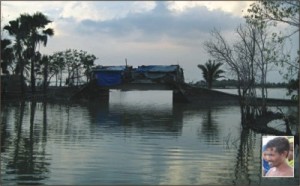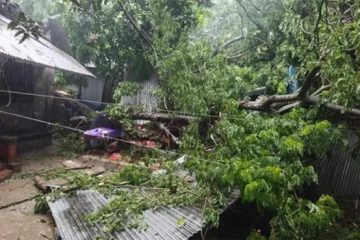Woes of waterlogged victims compounded as they slip out of spotlight; thousands still live on embankments, aid flow stopped
From The Daily Star
 Lutfar Gazi doesn’t even tries to recall that disastrous day when cyclone Aila ripped through the area he lives and wrecked havoc on his life in May this year. Since then he is too busy struggling to cope with the plight with little time to look back to his past.
Lutfar Gazi doesn’t even tries to recall that disastrous day when cyclone Aila ripped through the area he lives and wrecked havoc on his life in May this year. Since then he is too busy struggling to cope with the plight with little time to look back to his past.
Staring blank at the Kobadak river that left him homeless, he tries to figure out in vain how to maintain his family with no source of income and no-one for his rescue.
He was a resident of Shora-9 under Gabura union in Shyamnagar upazila, which was one of the worst cyclone-hit areas in Satkhira. In the last four months he knocked door to door to make a living for his six-member family. But eventually he returned to his family with the ‘solution’ of starvation every now and then.
In a worn-out, makeshift shack on the embankment, Lutfar now spends most of his time thinking of a living but only sees a bleak future ahead.
“I cannot bear anymore. Perhaps death in the storm was a better option than living in this hell,” he lets out a deep sigh.
“No home, no income, no food, no water — how can a human being live here? You will not realise how it feels when your children are crying for food and you have nothing to feed them,” he says as he speaks to The Daily Star correspondent visiting the Aila-hit areas.
“Everyone has forgotten us. My little children do not want to live in this small hut anymore but they have nowhere to go, nothing to do.
“Living in this hut during the day is like living in an oven. And when it rains miseries go unbound… perhaps we will die here helplessly,” Lutfar adds.
Lutfar is not alone. Several thousands of the Aila victims of different unions of Shyamnagar and Ashashuni upazilas are leading miserable lives in makeshift huts on roads and embankments.
Cyclone Aila struck a deadly blow on the country’s southwest coast on May 25, killing about a hundred and washing away several thousand houses and other property.
Though many of the victims have returned to what was left of their homes, people of the worst-affected Gabura, Padmapukur unions in Shyamnagar and Pratapnagar in Ashashuni are still living in a dismal condition.
They have no proper shelter, no food, and no safe drinking water or sanitation facilities.
A significant number of people have migrated to ‘safer’ places failing to bear the hardships. According to the deputy commissioner (DC) of Satkhira, around 10,000 people have shifted elsewhere.
The government initially came up with huge food and other modes of assistance and continued it for a few months. But it has been over a month that the government aid has stopped, increasing the survivors’ woes.
During a recent visit to different villages of Gabura and Padmapukur unions, it was found most of areas are still submerged by river waters.
The villagers say they could not return to their damaged or destroyed houses to rebuild everything due to lack of resources and help. Besides, things get worse during high tides and heavy rain as their living places are flooded through the breaches on the embankment.
The damaged embankment has now become home to thousands as water still gushes in the villages through the breaches during high tides.
“How can we return to our houses as those are still under knee-to-waist-deep water?” asks Mojibor Sana of Dumuria village.
The problem of safe drinking water is acute in the areas. The victims say though the government and some non-government organisations installed a number of tube-wells, but those are not adequate at all.
“The situation remains unchanged; it is rather deteriorating day by day as all the villages are still under water,” says Shaiful Azam Lenin, chairman of Gabura union.
“Around 25,000 out of 38,000 people in my union are leading inhuman lives on the embankment,” he informs, adding there is no government assistance for over a month.
The dam repairing work from which the victims used to get some food assistance has also stopped.
The sufferings of these people already leading a miserable life turn worse during rains.
“The fear of rain and storm always haunts us. Whenever it rains we clutch at the roof of the hut and pray to Allah so that the wind may not sweep it away. But rainwater enters our huts anyway making the floors muddy and unliveable,” comments Wazid Kumar Mridha of Jhapa village in Padmapukur.
“The situation is terrible,” sums up Amzad Hossain, chairman of Padmapukur union. He says over half of 32,000 people of his union are living on the embankment with no food or shelter.
The villagers say huge quantity of relief came soon after the cyclone, but the distribution has stopped for over a month. Besides, the “food for work” programme to repair the damaged embankment has also stopped for over a month, they complain.
Many victims allege they did not get the rice they were supposed to get despite working under the “food for work” programmes to repair the dams. Moreover, they allege they did not receive the money allocated by the government for rebuilding their houses.
DC of Satkhira Mohammad Abdus Samad told The Daily Star: “We have distributed rice before the Eid and during the Durga Puja.”
He said they would soon provide food assistance, medical support and sanitation to around 9,500 displaced families in the district and continue it till December.
The government has already given house-rebuilding money to the survivors who took refuge on the embankments and would distribute it again soon, he added.




















